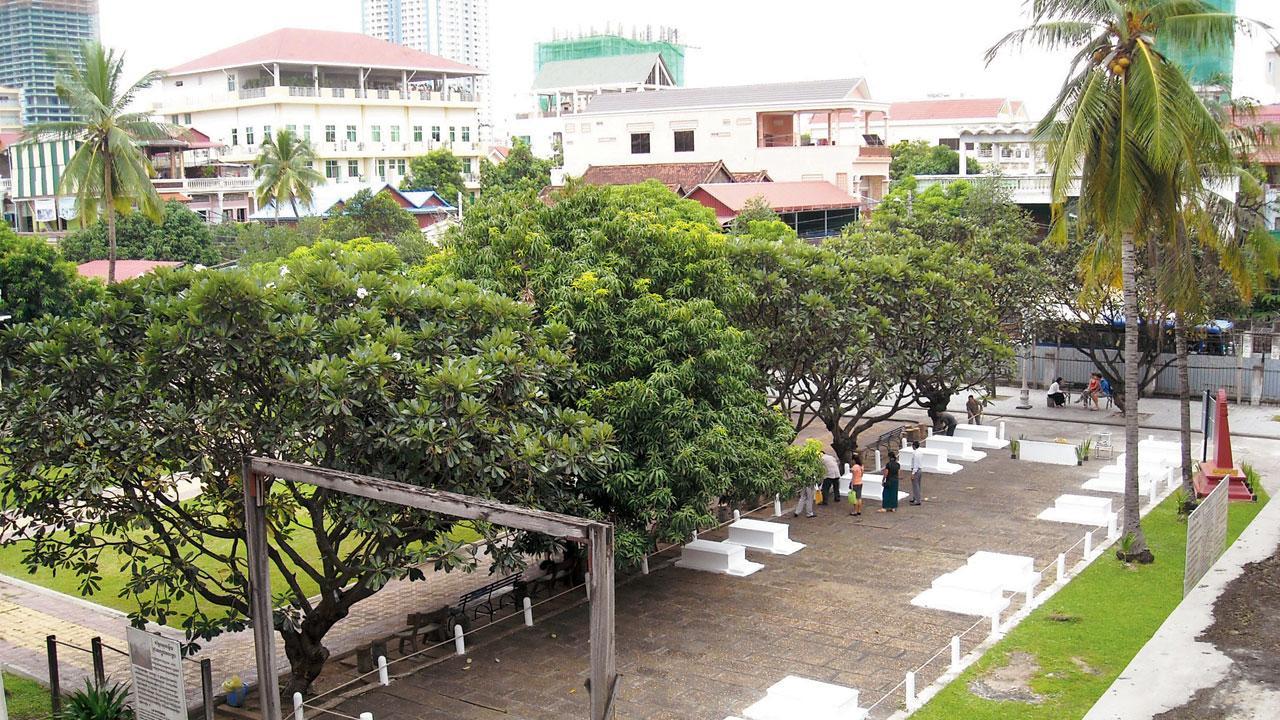Several virtual memorials have surfaced across India to salute those lives that were snatched away due to the pandemic. But will such digital platforms be able to fully relay and reflect the pain and grief, and most importantly, lessons to coming generations?

Tuol Sleng Genocide Prison, Phnom Penh. Pic/Fiona Fernandez
AMIDST soulful Buddhist chants, a little bit of John Lennon also wafted through the muggy morning air in September. As we stepped into Phnom Penh’s Tuol Sleng Genocide Prison, (S-21) – dictator Pol Pot’s secret prison – a young, scruffy Cambodian busker seated by the entrance crooned a gut-wrenching version of The Beatle’s ‘Give Peace a Chance.’
ADVERTISEMENT
Nothing prepared me for what was to follow. This school building (Tuol Svay Pray High School) had five wings and a large grassy compound. But, as we made our way from one wing to another, the horror unfolded. Thousands of black and white photographs of Cambodians stared back at us; prisoner beds lay as silent spectators. Prisoners were tortured here, interrogated and often, executed. Of the countless detainees, only seven survived. The gallows, graves (belonging to those who lost their lives here), and the claustrophobia-inducing sections within the barbed wire wings made even the strongest among us, get jelly-kneed.
Our next stop was the Choeung Ek Genocidal Center, the killing fields where the maverick leader’s heartless regime created mass graves. Every month, two-three trucks from S-21 would head to this spot where executions were carried out – in dozens or hundreds. The audio tour was a sensitive retelling of this chapter in an unforgettable period (1975-79) in the nation’s history. Green-topped mass graves, encased displays of shreds of clothing, bones, skulls and other reminders dotted the trail. Wherever we travelled across the Cambodian national capital, we posed just one question to a cross section of its citizens – why do you believe such mind-numbing and memorials are important? And the reasoning in each of their responses was similar – because we don’t want this and the coming generations to ever forget what a corrupt movement did to this great nation. Because we want our people to remember why democracy is important and must be kept alive at all costs. The memorials, they explained, will always remain a stark reminder; a wake-up call for their people. They felt very strongly about displaying it for all to see and remember its gory past, so history would never be repeated.
This detailed memory was from part of a trip to Cambodia nearly six years ago, and yet the imprint has never really left my mind. It scarred and scared in equal measure. So, when these Covid-19 memorials to honour lost lives began to emerge one by one across India’s digital landscape, I was transported to that visit. In fact, London’s National Covid Memorial Wall opposite the House of Parliament, is emerging as one of the most poignant physical reminders in these virus-hit times; it is giant wall mural that will display lakhs of red hearts to remember the lives lost in the UK to the deadly virus.
Their intent deserves applause and all our support, but dare I ask, will this effort be looked at with the same connection and compassion, say, a decade later? Will coming generations be able to gauge the grief, hurt and loss this pandemic inflicted upon the Indian population. It’s been our worst human tragedy in modern times, and one we hope is the last of this or any kind. While digital archives record our memories of the ones who passed on, a physical site might perhaps etch its impact on our lives and times in a stronger, starker manner, and for a longer period of time.
In these times where all funds should and must be directed for medical care and treatment, a fresh structure is the last thing that we need. Instead, an unused, abandoned wall or building façade [our cities are filled with them] will make for an ideal site for this special monument. Most crucially, when we are able to boot out this pandemic, we should be able to look at that physical memorial with a sense of positivity and belief, of having overcome this unseen and unforgiving enemy. Some might shrug it as hollow tokenism because one can’t bring back our loved ones, but perhaps what an 18-year-old college student in Phnom Penh told us, might help put things into perspective, “The Killing Fields Memorial, however chilling it might be for you, will always remind me that our country can rise from the ashes, eventually.”
mid-day’s Features Editor Fiona Fernandez relishes the city’s sights, sounds, smells and stones...wherever the ink and the inclination takes her. She tweets @bombayana
Send your feedback to mailbag@mid-day.com
 Subscribe today by clicking the link and stay updated with the latest news!" Click here!
Subscribe today by clicking the link and stay updated with the latest news!" Click here!











